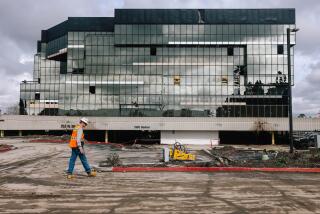Should Building Be Born Smart or Get Smart Later? : Alternative Shelter
- Share via
How “smart” does a building have to be--and when?
The concept of the “smart building” has been receiving a lot of attention recently but there’s a little ambiguity involved. It can mean an integrated building operation, that is, central computer equipment controlling air conditioning, heating, lighting, security and such services.
At other times it refers to loading a building with the latest in telecommunications equipment of all kinds, to be offered by the building or by a separate provider for shared use by the tenants. And sometimes it includes both.
Packing new office buildings with the latest electronic equipment is being pressed on developers as the way to cope with technological change. But two caveats have come to the notice of this column, one from the head of a major architecture and interior design firm and the other from a respected national research organization.
M. Arthur Gensler Jr., president of San Francisco-based Gensler & Associates/Architects (their Los Angeles office is in Century City), said: “It’s the user, not the building, that has to be ‘smart’ in order to understand and take advantage of new office building technology.”
He believes the capital investment in integrated building systems is still too huge to make the idea attractive to many developers, especially when the system may be obsolete in five years. “In telecommunications, no one can say what companies will need in five years--in fact, most companies don’t know what they need today.”
New Direction
He sees a movement away from integrated systems that require a huge capital outlay: “Stand-alone systems that operate independently are easier to change. Minicomputers are now used to manage a building’s security or lighting and they can be replaced as new technology is developed.”
In other words, it’s important to remain flexible to deal with the unexpected. Sometimes the unexpected is that the expected fails to happen.
“Only a few years ago,” Gensler remembered, “experts predicted that air conditioning loads would increase as more computers were installed in offices. In reality, the new computers generate less heat and air conditioning loads have remained about the same.”
As a result, some buildings may be over-engineered to meet “expecteds” that don’t materialize. For example, he pointed to a recent Xerox Corp. study indicating that, instead of needing larger cable capacity for tomorrow’s technology, an office’s communications and wiring requirements may actually decline with the growth of wire-saving technologies such as local area networks and fiber optics.
Chicago Experience
The question whether the “smart” equipment has to be built in at the start is addressed in an article, “Advanced Technology for Small Tenants,” in the February issue of Urban Land, a monthly publication of the Urban Land Institute-ULI. ULI is a nonprofit research institution headquartered in Washington.
It discussed the success of an outside company, Electronic Office Centers of America (referred to as EOCA), in the 5.2-million-square-foot, two-building Merchandise Mart and Apparel Center in Chicago. The complex has more than 2,000 tenants, primarily small, more than 900 of them independent businesses.
They already had their own telephone systems so the immediate prospect of marketing such services as shared PBX and shared telephone equipment were dim. But EOCA put together a package of discounted long-distance telephone services and succeeded in selling it. It later began offering shared PBX service and the leasing of telephone equipment and, still later, a shared computer network.
EOCA reported a profit in each of its first two years of operation off gross revenues of $2.9 million for the year ending in September, 1984, and an expected $4.1 million for the next year.
Two Lessons Learned
Dean Schwanke, ULI researcher and author of the article, commented: “With all the talk about non-intelligent buildings becoming obsolete, . . . it is refreshing to note that older projects, such as the Mart complex, can incorporate new technologies without major problems. And it is also refreshing to learn that, in fact, providing shared tenant services has not yet proven to be crucial in the overall success of any project.”
One of Schwanke’s conclusions is that shared tenant services are not suitable to all projects. Another is that when a developer is considering adding advanced technology to any new or existing building, a careful assessment of the local market is essential.
Both men seem to be saying, “Be smart when you smarten up your building.”
More to Read
Sign up for Essential California
The most important California stories and recommendations in your inbox every morning.
You may occasionally receive promotional content from the Los Angeles Times.





